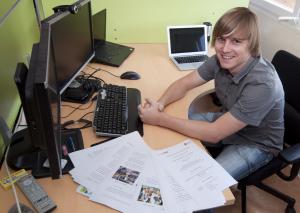The Graduate
29 Jul 2011
-
Robert Arnoux
JD's hundred-page dissertation—in English, which the French authorities exceptionally agreed to—has direct applications for IT tools.
The youngest member of the ITER staff, Jean-Daniel Delaplagne, 25, just became the Organization's youngest engineer. "JD," as he is universally known, obtained his engineering degree on 9 July from the respected Conservatoire National des Arts et Métiers (CNAM) in Aix-en-Provence, whose evening classes he had been attending for the past two years.
We now have an explanation for the dark circles under his eyes. They are not due to excessive nightlife, but rather to the long evenings he spent in the classroom. Three times a week, as most of his ITER colleagues headed home after a hard day's work, JD would go back to school.
"It's an old project of mine," he says. "After doing my BS in Canada and a Master's in Marseille that combined on-the-job training with academic learning, I knew that sooner or later I would aim for an engineering degree."
At ITER, which JD joined in the summer of 2008 first as an Osiatis employee, then, starting September 2010 as a full staff member, there was pride and rejoicing. Says Hans-Werner Bartels, ITER Section Leader for Project Information Systems and JD's boss: "JD is a very strong IT 'geek': he's a doer, he's effective. Now, he's proved his talent with an academic degree, which makes me extremely pleased and proud."
JD's hundred-page dissertation—in English, which the French authorities exceptionally agreed to—has direct applications for IT tools. "It is completely ITER-relevant," says Hans-Werner who acted as coach and mentor, and sat on JD's jury. "It will be of very practical use for the ITER Organization."
Entitled "Implementation of an Information Security Management System for the ITER Organization," the dissertation proposes a set of guidelines and procedures aimed at protecting the "assets" of the Organization. "The need for protection, confidentiality, integrity and availability of private or sensitive information is imperative," writes JD in the introduction to his dissertation, "[has become] one of the key challenges of this century for the IT industry."
We all know JD as the smiling kid who can solve almost any computer-related problem. But he's always been more than that and now it's official..."Of course we have to fix things," says Hans-Werner, "but it is important also to have a long-term vision. We need new developments for the future. I like excellence, I'm very positive about my staff. They should become the best experts in their field, and I hope JD has now set an example."
So JD—after you've had some rest and gotten rid of those dark circles under your eyes, you know what's expected of you: Aim for a doctorate!


